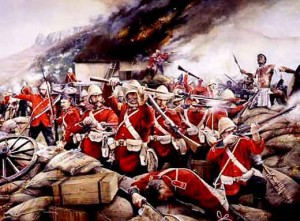At Kambula, in northwest Zululand, a force of 2,000 British and Colonial troops under the command of British Colonel Henry Evelyn Wood defeats 20,000 Zulus under King Cetshwayo, turning the tide in the favor of the British in the Zulu War.

In 1838, the Boers, migrating north to elude the new British dominions in the south, first came into armed conflict with the Zulus, who were under the rule of King Dingane at the time. The European migrants succeeded in overthrowing Dingane in 1840, replacing him with his son Mpande, who became a vassal of the new Boer republic of Natal.
In 1843, the British took over Natal and Zululand.
In 1872, King Mpande died and was succeeded by his son Cetshwayo, who was determined to resist European domination in his territory. In December 1878, Cetshwayo rejected the British demand that he disband his troops, and in January British forces invaded Zululand to suppress Cetshwayo.
The Zulu War had begun.
The British suffered grave defeats at Isandlwana, where 1,300 British soldiers were killed or wounded, and at Hlobane Mountain, but on March 29 the tide turned in favor of the British at the Battle of Khambula. At Ulundi in July, Cetshwayo’s forces were utterly routed, and the Zulus were forced to surrender to the British.
In 1887, faced with continuing Zulu rebellions, the British formally annexed Zululand, and in 1897 it became a part of Natal, which joined the Union of South Africa in 1910.

